Retrocomputing

Retrocomputing is the use of older computer hardware and software in modern times. Retrocomputing is usually classed as a hobby and recreation rather than a practical application of technology; enthusiasts often collect rare and valuable hardware and software for sentimental reasons. However, some do make use of it.[1] Retrocomputing often starts when a computer user realizes that formerly expensive fantasy systems like IBM mainframes, Digital Equipment Corporation (DEC) superminis, or Silicon Graphics (SGI) workstations have become affordable on the used computer market, usually in a relatively short time after the computers' era of use.
Many hobbyists have personal computer museums, with collections of working vintage computers such as Apple IIs, IBM PCs, ZX Spectrums, Atari, Commodore, Amigas and BBC Micros. Early personal computers based on the S-100 bus are also very popular among collectors, as well as a wide variety of machines running the CP/M operating system, such as Kaypros and Osbornes. However, many users use emulation software on more modern computers rather than using real hardware, in order to enjoy the experience, while preserving the aging electronics of the original. This is not considered to be retrocomputing by some, as it is rather an application of modern computer hardware. A third option is the use of home computer remakes, dedicated appliances, which do the emulation using dedicated hardware.
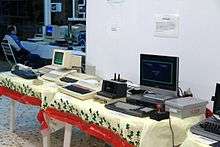
Historical retrocomputing
A more serious line of retrocomputing is part of the history of computer hardware. It can be seen as the analogue of experimental archaeology in computing. Some notable examples include the reconstruction of Babbage's Difference engine (more than a century after its design) and the implementation of Plankalkül in 2000 (more than half a century since its inception).
"Homebrew" computers
Some retrocomputing enthusiasts also consider the 'Homebrewing' (designing and building of retro- and retro-styled computers or kits), to be an important aspect of the hobby, giving new enthusiasts an opportunity to experience more fully what the early years of hobby computing were like.[1] There are several different approaches to this end. Some are exact replicas of older systems, and some are newer designs based on the principles of retrocomputing, while others combine the two, with old and new features in the same package. Examples include:
- Device offered by IMSAI, a modern, updated, yet backward-compatible version and replica of the original IMSAI 8080, one of the most popular early personal systems;
- Several Apple 1 replicas and kits have been sold in limited quantities in recent years, by different builders, such as the "Replica 1", from Briel Computers.;[2]
- A currently ongoing project that uses old technology in a new design is the Z80-based N8VEM;
- The Arduino Retro Computer kit is an open source, open hardware kit you can build and has a BASIC interpreter.[3] There is also a version of the Arduino Retro Computer that can be hooked up to a TV.;[4]
- There is at least one remake of the Commodore 64 using an FPGA configured to emulate the 6502.;[5]
- MSX 2/2+ compatible do-it-yourself kit GR8BIT, designed for the hands-on education in electronics, deliberately employing old and new concepts and devices (high-capacity SRAMs, micro-controllers and FPGA).
Vintage computers
The personal computer has been around since approximately 1976. But in that time, numerous technological revolutions have left generations of obsolete computing equipment on the junk heap. Nevertheless, in that time, these otherwise useless computers have spawned a sub-culture of vintage computer collectors, who often spend large sums to acquire the rarest of these items, not only to display but restore to their fully functioning glory, including active software development and adaptation to modern uses. This often includes so-called hackers who add-on, update and create hybrid composites from new and old computers for uses for which they were otherwise never intended. Ethernet interfaces have been designed for many vintage 8-bit machines to allow limited connectivity to the Internet; where users can access user groups, bulletin boards and databases of software. Most of this hobby centers on those computers manufactured after 1960, though some collectors specialize in pre-1960 computers as well.
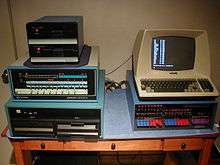
MITS Inc.
Micro Instrumentation and Telemetry Systems (MITS) produced the Altair 8800 in 1975, which is widely regarded as starting the microcomputer revolution.
IMSAI
IMSAI produced a machine similar to the Altair 8800, though considered by many to be a more robust design.
Processor Technology
Processor Technology produced the Sol-20. This was one of the first machines to have a case that included a keyboard; a design feature copied by many of later "home computers".
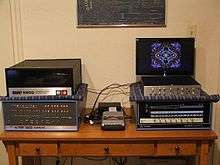
SWTPC
Southwest Technical Products Corporation (SWTPC) produced the SWTPC 6800 and later the SWTPC 6809 kits that employed the Motorola 68xx series microprocessors. The 68xx line was to be followed later by the 6502 processor that was used in many early "home computers", such as the Apple II.
Apple Inc.
The earliest of the Apple Inc. personal computers are among some of the most collectible. They are relatively easy to maintain in an operational state thanks to Apple's use of readily available off-the-shelf parts.
- Apple I: The Apple-1 was Apple's first product and has brought some of the highest prices ever paid for a microcomputer at auction.
- Apple II: The Apple II series of computers are some of the easiest to adapt, thanks to the original expansion architecture designed into them. New peripheral cards are still being designed by an avid thriving community, thanks to the longevity of this platform, manufactured from 1977 through 1993. Numerous websites exist to support not only the legacy users, but new adopters who weren't even born when the Apple II was discontinued by Apple.[6]
- Macintosh: Perhaps because of its friendly design and first commercially successful graphical user interface as well as its enduring Finder application that persists on the most current Macs, the Macintosh is one of the most collected and used of the vintage computers. With dozens of websites around the world, old Macintosh hardware and software is put into daily use. Many maintain vast collections of functional and non-functional systems, which are lovingly maintained and discussed on worldwide user forums. The Macintosh had a strong presence in many early computer labs, creating a strong nostalgia factor for former students who recall their first computing experiences.
IBM
- The IBM 1130 computing system from 1966 which still has a following of interested users, albeit via an emulator[7] rather than the actual machine.
- The 5100 also has an avid collector and fan base.
- The PC series (5150 PC, 5155 Portable PC, 5160 PC/XT, 5170 PC/AT) has become very popular in recent years, with the earliest models (PC) being considered the most collectible.
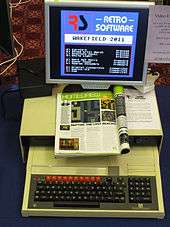
Acorn BBC & Archimedes
- The Acorn BBC Micro was a very popular British computer in the 1980s with home and educational users, and enjoyed near universal usage in British schools into the mid-1990s. It was possible to use 100K 5¼" disks and it had many expansion ports.
- The Archimedes series - the de facto successor to the BBC Micro - has also enjoyed a following in recent years, thanks to its status as one of the first computers to be based around ARM's RISC microprocessor.
Tandy/Radio Shack
- The Tandy/RadioShack Model 100 is still widely collected and used as one of the earliest examples of a truly portable computer. Other Tandy offerings, such as the TRS-80 line, are also very popular, and early systems, like the Model I, in good condition can command premium prices on the vintage computer market.
Sinclair
- The Sinclair ZX81 and ZX Spectrum series were the most popular British home computers of the early 1980s, with a wide choice of emulators available for both platforms. The Spectrum in particular enjoys a cult following due to its popularity as a games platform, with new games titles still being developed even today. Original "rubber key" Spectrums fetch the highest prices on the second hand market, with the later Amstrad-built models attracting less of a following. The earlier ZX81 is not as popular in original hardware form due to its monochrome display and limited abilities next to the Spectrum, but still unassembled ZX81 kits still appear on eBay occasionally.
MSX
- Although nearly nonexistent in the United States, the MSX architecture has strong communities of fans and hobbyists worldwide, particularly in Japan (where the standard was conceived and developed), Netherlands, Spain, Brazil, Argentina, Russia, Chile, the Middle East and others. New hardware and software are being actively developed to this day as well.
- One of the latest fundamental (from hardware and software perspectives) revivals of the MSX is the GR8BIT.
Robotron
- The Robotron Z1013 was an East German home computer produced by VEB Robotron. It had a U880 processor, 16 kByte RAM and a membrane keyboard.
- The KC 85 series of computers was a modular 8 bit computer system used in East German schools
Internet
There are a number of sites on the Internet catering to vintage computer hobbyists, including web pages, mailing lists, newsgroups, discussion forums, etc. Some are dedicated to certain specific systems while others are more generic and cover many different systems. Erik Klein's Vintage Computer Forum [8] is one example of a discussion page covering all aspects of the hobby.
cctech, also known as the "Classic Computers Discussion List", is an electronic mailing list about old computer technology, and is run by the Classic Computing organization.[9]
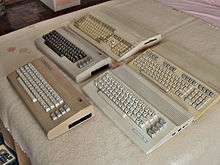
In popular culture
In an interview with Conan O'Brien, George R. R. Martin revealed that he writes his books using WordStar 4.0, an application dating back to 1987.[10]
Reception
Retrocomputing (and retrogaming as aspect) has been described by scholars as preservation activity and as aspect of the remix culture.[11]
See also
- Retrogaming
- Computer museum
- History of computer science
- History of computing hardware
- List of home computers by video hardware
- Computer Conservation Society
- Computer History Museum
- SIMH, the multi-system emulator.
- Vintage Computer Festival
- KansasFest
- Home computer remake
- Minimalist computing
- Retro Review
- Vintage software
Notes
- 1 2 "The Retrocomputing Museum". Catb.org. Retrieved 30 October 2013.
- ↑ http://www.brielcomputers.com/
- ↑ "Arduino Retro Computer with SD card and LCD display and Keyboard input with BASIC interpreter". amigojapan.github.com. Retrieved 30 October 2013.
- ↑ "Arduino Retro Computer TV". amigojapan.github.com. Retrieved 30 October 2013.
- ↑ "C-one Reconfigurable computer". Retrieved 6 September 2012.
- ↑ Weyhrich. Steven. "The Apple II". apple2history.org. p. 2. Retrieved 30 October 2013.
- ↑ "Simulating the IBM 1130 on 21st-century hardware". IBM1130.org. Retrieved 30 October 2013.
- ↑ "The Vintage Computer: My Collection of Vintage Machines". Vintage-computer.com. January 2012. Retrieved 30 October 2013.
- ↑ http://www.ClassicCmp.org Classic Computing
- ↑ "George R.R. Martin Writes on a DOS-Based Word Processor From the 1980s". Retrieved 20 September 2015.
- ↑ Yuri Takhteyev, Quinn DuPont (2013). "Retrocomputing as Preservation and Remix" (PDF). iConference 2013 Proceedings (pp. 422-432). doi:10.9776/13230. University of Toronto. Retrieved 2016-03-26.
This paper looks at the world of retrocomputing, a constellation of largely non-professional practices involving old computing technology. Retrocomputing includes many activities that can be seen as constituting “preservation.” At the same time, it is often transformative, producing assemblages that “remix” fragments from the past with newer elements or joining together historic components that were never combined before. While such “remix” may seem to undermine preservation, it allows for fragments of computing history to be reintegrated into a living, ongoing practice, contributing to preservation in a broader sense. The seemingly unorganized nature of retrocomputing assemblages also provides space for alternative “situated knowledges” and histories of computing, which can sometimes be quite sophisticated. Recognizing such alternative epistemologies paves the way for alternative approaches to preservation.
References
- "Preserving Computing's Past: Restoration and Simulation" Max Burnet and Bob Supnik, Digital Technical Journal, Volume 8, Number 3, 1996.
External links
- Retro Computer Museum, A computer museum in Leicestershire, UK with regular "come and play" open days.
- ZX81 Museum, Online museum showcasing the Sinclair ZX81 computer.
- Vintage Computing Festival
- Retrocomputing Museum for re-implementations of old programming languages.
- RETRO - German paper mag about digital culture
- The Centre for Computing History The Centre for Computing History - UK Computer Museum
- Video Dr. Thomas Haddock "Guide to Collecting Microcomputers"
- Apple II History Detailed history of the Apple II series.
- The MSX Resource Center
- Living Computer Museum Request a Login from the LCM to interact with vintage computers over the internet.
- Old-computers.com Information about vintage computers.
- bitsavers Software and PDF Document archive about older computers.